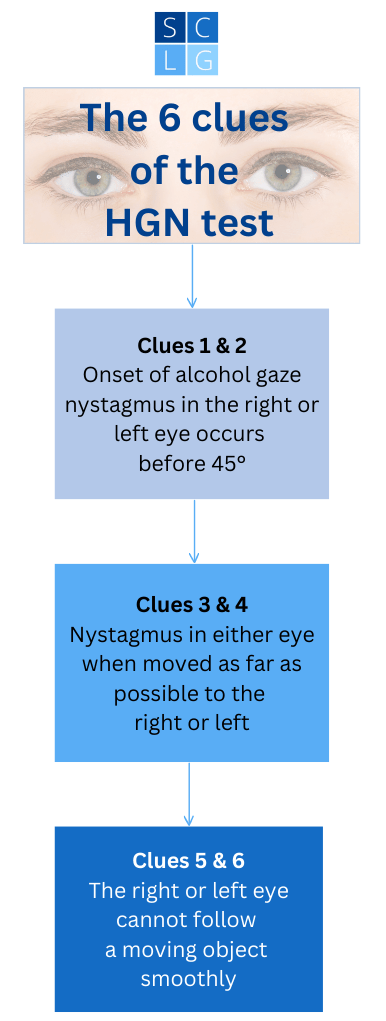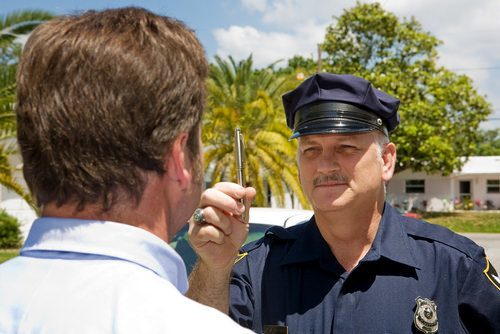The Horizontal Gaze Nystagmus Test (HGN) is a standardized field sobriety test (FST) that police use to see if you are under the influence of alcohol or have a blood alcohol content (BAC) of .08%.
During the HGN test, police study your eyes as you follow a stimulus (usually a penlight) to the left and right. How you perform on the test helps police determine whether there is probable cause to arrest you for DUI.
What police are looking for
While you are performing the test, the officer notes the angle at which your pupil starts to exhibit “nystagmus” (involuntary jerking of the eye).
Early onset of nystagmus prior to or at a 45-degree angle is a “clue” associated with a high blood alcohol concentration.
The HGN test is unreliable
Law enforcement officials are notorious for administering HGN tests incorrectly. This generally stems from
- lack of training,
- improper training, and
- failure to adhere to the proper procedures.
Plus, according to the National Highway Transportation Safety Administration (NHTSA), studies revealed the HGN Test to be only 77% reliable in determining whether you have a blood alcohol concentration above .10%.1
Consequently, countless innocent drivers are arrested daily due to improper testing instructions and methods.

In the article below, our California DUI lawyers will first briefly describe the horizontal gaze nystagmus test. We will then discuss how the test is administered.
Next, we will highlight the clues police look for when administering the test. We will then detail the current California case law on HGN.
Finally, we will show you how to attack the validity and/or administration of the HGN test both in and out of the courtroom.
- 1. Field sobriety tests & DUI investigations
- 2. Horizontal gaze nystagmus test instructions
- 3. Horizontal gaze nystagmus test clues
- 4. California case law on the horizontal gaze nystagmus test
- 5. Horizontal gaze nystagmus test reliability – attacking it inside and outside the courtroom
- Additional resources

Early onset of nystagmus prior to or at a 45-degree angle is a clue associated with a high blood alcohol concentration.
1. Field sobriety tests & DUI investigations
The eye test given at the roadside in a DUI investigation is a test of “horizontal gaze nystagmus.”2
Horizontal gaze nystagmus refers to an involuntary jerking of the eyes as the eyes gaze toward the side. In addition, if you are experiencing nystagmus, you are unaware of its occurrence.3
The HGN test is one of three standardized field sobriety tests. The other two standardized field sobriety tests are
- the one-leg stand test and
- the walk-and-turn test.
These three tests are considered “standardized” largely because they have been the subject of numerous scientific studies clearly demonstrating the correlation between the three tests and DUI impairment.4
Out of all the FSTs administered by law enforcement officials, HGN has proven to be the most scientifically reliable field sobriety test.5
Under the HGN test, jerking of your eyes should become considerably noticeable when you are impaired by alcohol and certain drugs such as depressants. Furthermore, as your blood alcohol concentration increases, your eyes should begin to jerk sooner as they move to the side.6
After the arrest
If you are arrested for DUI in California, you are then required to take an evidentiary breath or blood test. (If the police suspect you ingested drugs, then you are required to take the blood test since breathalyzers can detect only alcohol.)
If you refuse to take a breath or blood test, then the police may get a warrant, restrain you, and take a blood sample by force.

Under the HGN test, jerking of the eyes should become considerably noticeable when a person is impaired.
2. Horizontal gaze nystagmus test instructions
Below are the instructions given by the National Highway Traffic Safety Administration (NHTSA), to DUI law enforcement officers on how to administer and score the horizontal gaze nystagmus sobriety test:
STEP 1:
Give the DUI suspect the following instructions from a position of interrogation (that is, with your weapon away from the suspect):
STEP 2:
I AM GOING TO CHECK YOUR EYES.
-
- Request that the DUI suspect remove their glasses or hard contact lenses at this time if they are being worn. Nystagmus is not influenced by how clearly the suspect can see the object they are to follow. Check for equal pupil size, resting nystagmus, and equal tracking.
NOW KEEP YOUR HEAD STILL AND FOLLOW THIS WITH YOUR EYES.
-
- Indicate what [stimulus] they are to follow.
DO NOT MOVE YOUR EYES BACK TO THE CENTER UNTIL I TELL YOU.
-
- If the DUI suspect moves their head, use a flashlight or your free hand as a chinrest. Position the stimulus 12-15 inches from the suspect’s eyes with your eye level above his.
STEP 3
Check the suspect’s right eye by moving the object to the suspect’s right. Have the suspect follow the object until the eyes cannot move further to the side. Make this movement in about two seconds, and observe:
- Whether the DUI suspect was able to follow the object smoothly or whether the motion was quite jerky (lack of smooth pursuit); and
- How distinct and sustained the nystagmus is at the maximum deviation.
STEP 4
Move the object a second time to the 45-degree angle of gaze, taking about four seconds.
- As the subject’s eye follows the object, watch for it to start jerking. If you think you see distinct nystagmus, stop the movement to see if the jerking continues.
- If it does, this point is the angle of onset. If it does not, keep moving the object until the jerking does occur or until you reach the imaginary 45-degree angle.
- Note whether or not the onset occurs before the 45-degree angle of gaze. (The onset point at a BAC of 0.10 percent is about 40 degrees.)
STEP 5
If the DUI suspect’s eyes start jerking before they reach 45 degrees, check to see that some white of the eye is still showing on the side closest to the ear, as in the photograph.
- If no white of the eye is showing, you either have taken the eye too far to the side (that is, more than 45 degrees) or the person has unusual eyes that will not deviate very far to the side.
- Use the criteria of onset before 45 degrees only if you can see some white at the outside of the eye.
STEP 6
Repeat this entire procedure for the DUI suspect’s left eye.
- When observing the left eye at 45 degrees of gaze, some white of the eye again should be visible at the outside (closest to the ear) of the eye.7
3. Horizontal gaze nystagmus test clues
To determine whether you are intoxicated, law enforcement officials will typically watch for three major “clues” of intoxication per each eye during the administration of the test.
Keeping these clues in mind, officers will then give one point for each spotted clue. Since there are three clues per eye, six points are potentially given out during the testing.
If you score four or more points out of the six possible points on this test, officers will classify your BAC as above 0.10 percent.8
Using this criterion, officers will correctly classify about 77 percent of their suspects concerning whether they are drunk driving.9 That probability had been determined during limited laboratory and field-testing and is given simply to help an officer weigh the various sobriety tests as they decide whether to make an arrest.10
The Horizontal Gaze Nystagmus Test Scoring Sheet composed of the major clues of intoxication is as follows:
- CLUES 1 & 2: Onset of alcohol gaze nystagmus in the right or left eye occurs before 45 degrees. Officers are not to score this item unless some white is visible on the outside of the right or left eye (closest to the ear) at the point of onset.
- CLUES 3 & 4: Nystagmus in the right or left eye when moved as far as possible to the right or left (for example, distinct and sustained nystagmus at maximum deviation). Officers are not to score this item if they only see the faint jerking that occurs at the onset point.
- CLUES 5 & 6: The right or left eye cannot follow a moving object smoothly. If an officer scores this item, they must be sure that the jerkiness was not due to them moving the object in a jerky manner. The greater the alcohol impairment, the more distinct and sustained the nystagmus will be at maximum deviation.11
4. California case law on the horizontal gaze nystagmus test
The prevailing trend throughout courts in California is to accept horizontal gaze nystagmus as evidence of impairment, provided the proper scientific foundation is laid.12 Nevertheless, courts in California almost always reject any attempt to derive a quantitative estimate of BAC from nystagmus.13
Courts in California have found HGN test results to be sufficiently reliable to be introduced in evidence at trial
The HGN test is considered a reliable and valid testing procedure to help police determine whether there is probable cause to arrest you for DUI.14 Hence, HGN test results may be admitted into evidence to corroborate or attack the allegation that you had been driving under the influence of alcohol.15
Consequently, prosecutors almost always have officers testify as to the
- administration,
- clues and
- scoring
of the HGN test to support the assertion that you have been intoxicated at the time of your arrest.16
HGN cannot be used to establish your blood alcohol concentration quantitatively.
An arresting officer cannot attempt to testify at trial as to their opinion concerning your BAC, in quantitative terms, based solely on the angle of onset of HGN.17
Therefore while an officer can testify whether or not there had been an angle of onset at 45 degrees, the police officer may not use the HGN test results to quantify your specific BAC level.18

The HGN Test is deemed to be only 77% accurate in determining whether a driver has a blood alcohol concentration above 0.10
5. Horizontal gaze nystagmus test reliability – attacking it inside and outside the courtroom
According to the government’s own studies, the HGN Test is deemed to be only 77% accurate in determining whether you have a blood alcohol concentration above .10.19 This essentially means that roughly one out of four people who fail the test are NOT intoxicated.
Even the 77% reliability is based on the assumption that the test is administered properly in accordance with NHTSA guidelines. In reality, however, not only does the test carry its own inherent flaws, but its administration by law enforcement officials, including
often fall short of NHTSA standards.
According to San Bernardino DUI lawyer Michael Scafiddi,
“the reliability of the horizontal gaze nystagmus test is in serious question. Any good DUI defense attorney should therefore be able to expose several weaknesses in the procedures / administration of the horizontal gaze nystagmus test in a DMV hearing and/or in the courtroom.”
Some of these weaknesses are ripe for attack by our California DUI defense lawyers include the following.
Difficultly in estimating a 45-Degree Angle:
- Although distinct and sustained nystagmus at maximum deviation indicates intoxication, the degree of impairment determined by the HGN test is indicated by the angle at which nystagmus begins.
- This means that officers have to estimate the angle, particularly the 45-degree angle, since that is the crucial marker for estimating BAC. Needless to say, with estimation comes uncertainty and subjectivity.
Drugs, medicines, or physical conditions:
- Nystagmus may be due to causes other than alcohol in three to four percent of the population. Some of these causes include inner ear fluid movement, congenital conditions, seizure drugs, eye strain, phencyclidine (PCP), barbiturates, tranquilizers, and other depressants.20
- Expert testimony by a neuro-ophthalmologist or oculographer can show that your nystagmus had nothing to do with alcohol or drugs; instead, you may have a physiologic (rather than pathologic) end-point nystagmus that is normal for you.
Head injury:
- A large disparity between the performance of the right and left eye may indicate brain damage rather than any intoxication.
- Significantly, you need not have been aware of or diagnosed with any brain damage at the time of the HGN testing for you to raise this defense. The brain damage simply must have potentially existed at the time you performed the HGN test.
Contact lenses:
- Any observed nystagmus, including any distinct and sustained nystagmus at maximum deviation, may be due to irritation and/or impairment from the wearing of contacts.
- If the officer is to follow proper NHTSA protocols, they must ask you to take out any “hard” contact lenses you might be wearing prior to the testing.21
- Clearly, however, if you wear a pair of contact lenses that may cause you irritation and/or unnatural pupil movement, their removal prior to HGN testing may be essential for you to perform the test properly.
- Conversely, if you suffer from some sort of eye disorder or ‘twitch” that requires you to wear corrective lenses and you did not wear them at the time of testing, then any observed nystagmus may be attributed to the absence of corrective eyewear.
Improper positioning:
If
- the officer does not position the stimulus within 12-15 inches from your eyes and/or
- the eyes of the officer are not above your eye level when they administer the test,
then the results of the test may be tainted.22
Flashing Lights:
If
- the officer has flashing lights emanating from their vehicle and/or
- flashing lights are emanating on or around the stimulus,
then this may instigate the onset of nystagmus as opposed to any intoxication.
Lack of a steady hand:
- If the HGN test is to be administered properly, then the officer must move the stimulus in a steady, consistent and even side-to-side manner.
- Conversely, if the officer moves the object in a jerky manner, then the observed nystagmus may be attributed to something other than intoxication.23
Additional resources
For more in-depth information, refer to these articles:
- Nystagmus among suspected amphetamine impaired drivers – Journal and Forensic and Legal Medicine.
- End-position nystagmus as an indicator of ethanol intoxication – Science & Justice.
- Can Your Eyes Be Used Against You–The Use of the Horizontal Gaze Nystagmus Test in the Courtroom – Journal of Criminal Law and Criminology.
- Horizontal Gaze Nystagmus: A Review of Vision Science and Application Issues – Journal of Forensic Sciences.
- Horizontal Gaze Nystagmus – A Closer Look – Jurimetrics.
Legal References:
- U.S. Department of Transportation “DWI Detection and Standardized Field Sobriety Testing” NHTSA Student Manual (February 2015): VII/3. The HGN does not test for Vestibular Nystagmus, which comprises: Rotational Nystagmus, Post-Rotational Nystagmus, Caloric Nystagmus, Positional Alcohol Nystagmus.
- Id., at VIII/4. Nystagmus comes from the Greek words νμσταγμνσ (drowsiness) and νμσταζειν (to nod in one’s sleep). During REM sleep the eyes oscillate back and forth, similar to the nystagmus “jerking” movement.
- Id., at VIII/4
- Id., at VIII/1; See also Burns & Moskowitz, Psychophysical Tests for DWI Arrest, U.S. Dept. of Transportation Rep. No. DOT-HS-802-424 (1977) (recommended the three-test batter of one-leg stand, walk and turn, and HGN to aid officers in discriminating BAC level); Anderson, Schweitz & Snyder, Field Evaluation of Behavioral Test Battery for DWI, U.S. Dept. of Transportation Rep. No. DOT-HS-806-475 (1983) (field evaluation of the field sobriety test battery (HGN, one-leg stand, and walk and turn) conducted by police officers from four jurisdictions indicated that the battery was approximately 80% effective in determining BAC above and below .10 percent).
- Id., at VII/2
- Id., at VII/2
- Id., at VIII/6; Please also see, Wilkinson, Kime & Purnell, Alcohol and Human Eye Movement, 97 BRAIN 785 (1974) (oral dose of alcohol-impaired eye movement of all subjects); Lehti, The Effect of Blood Alcohol Concentration on the Onset of Nystagmus, 136 BLUTALKOHOL 414 (West Germany 1976) (noted a statistically significant correlation between the BAC and the angle of onset of nystagmus with respect to the midpoint on the field of vision).
- Id., at VIII/8
- Id., at VIII/3. One study claimed that performing all three FSTs yields a 95% accuracy rate for determining whether the suspect has committed DUI. Florida Department of Transportation, State Safety Office, A Florida Validation Study of the Standardized Field Sobriety Test (S.F.S.T.) Battery, A1-97-05-14-01 (1997).
- Id., at VIII/8; See also Burns & Dioquino, Field Evaluation Study of the Standardized Field Sobriety Test (SFST) Battery, (Florida, 1997). Study demonstrated that officers trained under NHTSA guidelines and experienced in the application of the SFST battery in the field were accurate in 95% of arrest decisions and 85% of release decisions.
- Id., at VIII/8
- Id., at III/10; The National Traffic Law Center (NTLC) has a list of every state’s Appellate Court/Supreme Court case addressing HGN and SFST issues; See also California v. Loomis (1984) 156 Cal. App. 3d Supp. 1, 5-6, 203 Cal. Rptr. 767, 769-70.
- Id.,
- California v. Joehnk (1995) 35 Cal. App. 4.
- Same. HGN test satisfies the Frye test for reliability and admissibility of “new” scientific evidence; that is, the test has found general acceptance/legitimacy in the relevant scientific community.
- Id.,
- Id., 1508, 18.
- California v. Loomis (1984) 156 Cal. App. 3d Supp. 1, 5-6, 203 Cal. Rptr. 767, 769-70.
- Id.,
- NHTSA Student Manual (2006), at VIII/5-8
- Id., at VIII/6; See also Baloh, Sharma, Moskowitz & Griffith, Effect of Alcohol and Marijuana on Eye Movements, 50 AVIAT. SPACE ENVIRON. MED., Jan 1979; and Umeda & Sakata, Alcohol and the Oculomotor System, 87 ANNALS OF OTOLOGY, RHINOLOGY & LARYNGOLOGY, May-June 1978.
- Id., at VIII/6
- Id., at VIII/6
- Id., at VIII/5-8
